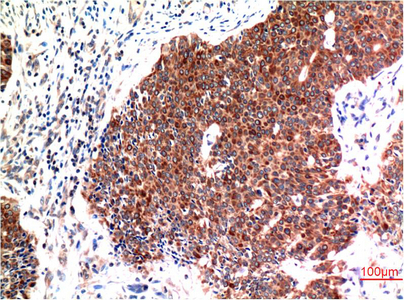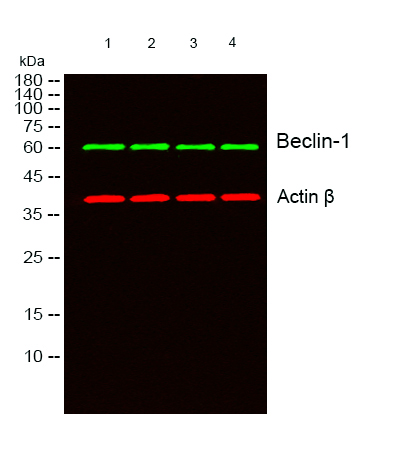Beclin-1 mouse Monoclonal Antibody(5C2)
- Catalog No.:YM3655
- Applications:WB;IHC;IF
- Reactivity:Human;Rat;Mouse;Bovine
- Target:
- Beclin 1
- Fields:
- >>Autophagy - other;>>Mitophagy - animal;>>Autophagy - animal;>>Apoptosis - multiple species;>>Apelin signaling pathway;>>Alzheimer disease;>>Amyotrophic lateral sclerosis;>>Huntington disease;>>Spinocerebellar ataxia;>>Pathways of neurodegeneration - multiple diseases;>>Shigellosis;>>Kaposi sarcoma-associated herpesvirus infection
- Gene Name:
- BECN1
- Protein Name:
- BECN1
- Human Gene Id:
- 8678
- Human Swiss Prot No:
- Q14457
- Mouse Swiss Prot No:
- O88597
- Rat Swiss Prot No:
- Q91XJ1
- Immunogen:
- Synthetic Peptide of Beclin-1 at AA range of 110-190
- Specificity:
- Beclin-1 protein detects endogenous levels of BECN1
- Formulation:
- Liquid in PBS containing 50% glycerol, 0.5% BSA and 0.02% sodium azide.
- Source:
- Monoclonal, Mouse
- Dilution:
- WB 1:1000-2000, IHC 1:100-200. IF 1:50-200
- Purification:
- The antibody was affinity-purified from mouse ascites by affinity-chromatography using specific immunogen.
- Concentration:
- 1 mg/ml
- Storage Stability:
- -15°C to -25°C/1 year(Do not lower than -25°C)
- Other Name:
- BECN1
- Observed Band(KD):
- 60kD
- Background:
- beclin 1(BECN1) Homo sapiens This gene encodes a protein that regulates autophagy, a catabolic process of degradation induced by starvation. The encoded protein is a component of the phosphatidylinositol-3-kinase (PI3K) complex which mediates vesicle-trafficking processes. This protein is thought to play a role in multiple cellular processes, including tumorigenesis, neurodegeneration and apoptosis. Alternative splicing results in multiple transcript variants. [provided by RefSeq, Sep 2015],
- Function:
- function:Plays a central role in autophagy (By similarity). May play a role in antiviral host defense. Protects against infection by a neurovirulent strain of Sindbis virus.,similarity:Belongs to the beclin family.,subcellular location:Expressed in dendrites and cell bodies of cerebellar Purkinje cells.,subunit:Interacts with GOPC and GRID2. Interacts with AMBRA1. Probably forms a complex with AMBRA1 and PIK3C3 (By similarity). Interacts with BCL2 and BCL2L1.,tissue specificity:Ubiquitous.,
- Subcellular Location:
- Cytoplasm . Golgi apparatus, trans-Golgi network membrane ; Peripheral membrane protein . Endosome membrane ; Peripheral membrane protein . Endoplasmic reticulum membrane ; Peripheral membrane protein . Mitochondrion membrane ; Peripheral membrane protein . Endosome . Cytoplasmic vesicle, autophagosome . Interaction with ATG14 promotes translocation to autophagosomes. Expressed in dendrites and cell bodies of cerebellar Purkinje cells (By similarity). .; [Beclin-1-C 35 kDa]: Mitochondrion . Nucleus . Cytoplasm .; [Beclin-1-C 37 kDa]: Mitochondrion .
- Expression:
- Ubiquitous.
- June 19-2018
- WESTERN IMMUNOBLOTTING PROTOCOL
- June 19-2018
- IMMUNOHISTOCHEMISTRY-PARAFFIN PROTOCOL
- June 19-2018
- IMMUNOFLUORESCENCE PROTOCOL
- September 08-2020
- FLOW-CYTOMEYRT-PROTOCOL
- May 20-2022
- Cell-Based ELISA│解您多样本WB检测之困扰
- July 13-2018
- CELL-BASED-ELISA-PROTOCOL-FOR-ACETYL-PROTEIN
- July 13-2018
- CELL-BASED-ELISA-PROTOCOL-FOR-PHOSPHO-PROTEIN
- July 13-2018
- Antibody-FAQs
- Products Images

- Immunohistochemical analysis of paraffin-embedded Human Brain Tissue using Beclin-1 Mouse mAb diluted at 1:200.

- Immunohistochemical analysis of paraffin-embedded Human Breast Carcinoma Tissue using Beclin-1 Mouse mAb diluted at 1:200.

- Western blot analysis of lysates from 1) 293T Cell Lysate, 2) C2C12 Cell Lysate, 3) Rat Brain Tissue cells, (Green) primary antibody was diluted at 1:1000, 4°over night, secondary antibody(cat:RS23910)was diluted at 1:10000, 37° 1hour. (Red) Actin β Polyclonal Antibody (cat:YT0099) antibody was diluted at 1:5000 as loading control, 4° over night,secondary antibody(cat:RS23720)was diluted at 1:10000, 37° 1hour.



